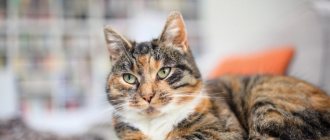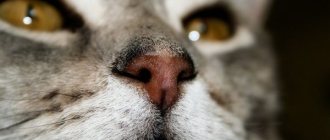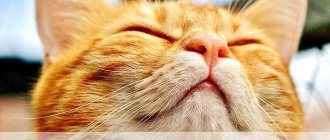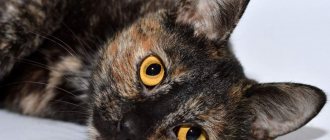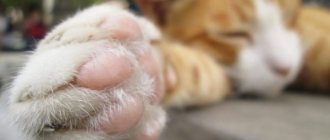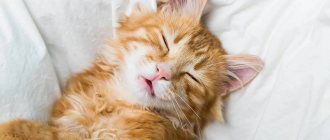What will you learn from the article?
- Symptoms of flatulence How to tell if your cat has gas
- Flatulence and other health problems
- Veterinary drugs for flatulence
- What foods should not be included in a cat's diet?
Flatulence in a cat (passage of gas) is a natural process in the functioning of the cat’s digestive system. Cats, like people and other pets, fart from time to time. However, excess gases in the intestines and their discharge, which is accompanied by foul odors, is not the norm. This is an alarm bell indicating gastrointestinal problems and a reason to contact a veterinarian.
How can you tell if your cat has flatulence? What are the reasons for this phenomenon? How to remove gas from a cat and how to prevent its occurrence? When do you need to take your cat to the doctor urgently? We will answer all these questions in our article.
Symptoms of flatulence
Loud sounds and unpleasant odors when a cat passes gas are the main symptoms of flatulence. However, this process is not always accompanied by a stench. Other signs may indicate problems with the digestive tract.
How to tell if your cat has gas
- The cat's stomach growls loudly.
- Pain in the stomach area. The cat won't let you touch its belly.
- Stomach bloating in a cat.
- The cat farts often.
- Hiccups.
- Diarrhea and gases suddenly released from the anus.
- Vomit.
- Muscle spasms in the abdominal area.
- The cat is worried and meows loudly and pitifully in pain.
- The animal hides and does not allow itself to be touched.
Bloating, vomiting, diarrhea and flatulence may indicate other problems with the animal's gastrointestinal tract. Take your cat to the veterinarian for a diagnosis and treatment.
Constipation
A problem that may not seem scary at first glance can bother your cat quite a lot.
Dry food in the form of granules in combination with insufficient drinking makes the situation worse.
Many cats even get used to drinking from the toilet. On the one hand, this may seem convenient, but you should always remember about possible dangers:
- cleaning product residues pose a risk of poisoning;
- cold water can cause a cold;
- absolute lack of hygiene.
Therefore, if such a problem exists, and the cat lives in conditions of constant water shortage, you should immediately take action: leave a small sippy cup next to the bowl. You should wash it at least 2 times a day, and also replace the liquid twice a day.
Causes of flatulence
Excessive gas can be caused by a number of reasons, but the most common is the cat's poor diet. Pet owners should be careful about what their cat eats. Choose only good fresh foods and balanced, high quality feed.
Causes of flatulence in cats:
- Food allergies.
- A diet high in fiber and dairy products.
- Expired food and spoiled products.
- Swallowing food too quickly (aerophagia).
- Binge eating.
- Accumulation of bezoars (hairballs) in the cat’s gastrointestinal tract.
- Helminthic infestations.
- Insufficient physical activity.
- A sharp change in diet, switching to other types of food.
- Serious diseases of the gastrointestinal tract.
Flatulence and other health problems
In rare cases, the phenomenon of flatulence indicates serious problems with the cat's health.
Excessive gas formation due to large amounts of air swallowed during feeding (aerophagia):
- stomatitis;
- stress;
- hypersalivation (increased salivation);
- nasal congestion (runny nose in a cat);
- cardiovascular diseases.
Foul odor due to fermentation processes in the intestines:
- parasitic disease trichomoniasis;
- gastritis;
- inflammatory processes in the gastrointestinal tract;
- dysbacteriosis;
- bowel cancer.
Flatulence in a cat after birth, accompanied by bloating, may indicate serious postpartum complications and requires immediate attention from a veterinarian.
Flatulence in a kitten
If a kitten farts frequently and has a swollen belly, this most often does not require a visit to the veterinarian.
There are three main causes of flatulence in kittens:
- A sharp transition from mother's milk to another type of nutrition.
- Kittens suck milk greedily and quickly, competing with each other, so they swallow too much air.
- Kittens, when they first learn to lap and eat on their own, swallow food too quickly.
Important: a swollen belly in kittens is often due to infection with worms. Carry out antiparasitic treatment in accordance with your veterinarian's recommendations.
Do they fart or not?
Owners often have a question: “Can cats fart?” Cats fart, and this is a completely normal process of life. However, this happens very rarely. If your cat farts too often, you should pay attention to your pet's health.
During the digestion of food, gases are formed in the cat's intestines. Gases can also form in the stomach due to the action of carbohydrates. Unlike dogs, cats can form a sufficient amount of carbohydrates themselves. Therefore, their increased content in food can cause increased gas formation in the cat’s stomach.
When to urgently contact a veterinarian
Most often, excessive gas formation, frequent release of gases does not require the intervention of veterinary specialists.
A visit to the veterinarian is necessary if these symptoms are accompanied by others:
- bloody diarrhea;
- vomit;
- decreased appetite;
- complete refusal to eat;
- painful bloated stomach;
- restless cat behavior.
The doctor must examine the animal, give it the correct diagnosis, and prescribe the necessary treatment.
Diseases
Flatulence is a faithful companion to inflammatory diseases of the digestive system. Most often it accompanies colitis. In addition to rumbling and bloating, the animal experiences tension in the abdominal wall, constipation alternating with diarrhea, blood and mucus in the stool, tenesmus, and pain during defecation. Violation of general condition: apathy, loss of appetite. Colitis can be complicated by a fungal or bacterial infection. It can develop due to improper feeding, helminthic infestation, poisoning, frequent and severe stress.
Diagnostics
The diagnosis of “flatulence” is made by a doctor in a veterinary clinic based on a study of the cat’s history, lifestyle, diet, and the presence of concomitant pathologies. The owner must be prepared to answer a number of questions about the type of food, brand of food, time of transfer from one type of food to another, and the volume of the daily portion.
Additionally, a number of diagnostic tests are carried out to exclude other diseases.
- Analysis of stool for parasite infestation.
- Blood analysis.
- X-ray of the abdominal cavity.
- Ultrasound of the intestines.
- Analysis of urine.
- Biopsy.
Remember the events that preceded the occurrence of a health problem, tell your doctor about them. Maybe the cat picked up something and ate it while walking outside, stole something from the table, or climbed into the trash can.
Increased gas formation from dry food
When considering the described composition of ready-made dry food, cereal nutrients often come first. Considering the physiology of a cat, this is an undesirable component of food.
Statistics show that owners who organize feeding with dry food often turn to specialists for problems with flatulence. A natural diet or feeding canned food is more gentle on the cat’s digestive system, and flatulence occurs less frequently.
If the cat is on dry food, then the initial response to flatulence is to change the type of feeding. Translation should be carried out slowly, gradually, carefully.
Treatment of flatulence in cats at home
Restoring your cat's digestion is the first thing to do when your veterinarian diagnoses flatulence. Treatment is usually carried out on an outpatient basis, and cats quickly return to normal.
It is important to correctly determine the cause of increased gas formation.
The treatment regimen and prescription of medications and procedures will depend on the cause of flatulence:
- If internal parasites are the cause of bloating, your doctor will prescribe a course of antiparasitic treatment. Medicines for worms should be prescribed by a veterinarian depending on the type of parasites and the degree of infestation.
- An assessment and review of the diet is necessary if the cause of gas in a cat is an incorrect diet, a sudden change in the type of food, or a transition to a new brand of food.
- If the cause is intestinal disease, therapy will be aimed at eliminating these pathologies.
- Increased gas formation due to too rapid absorption of food can be eliminated by the owner at home without medication. Cats living together should be fed separately to avoid competition over food. The problem of rapid feed absorption is solved by automatic feeders with dispensers. Placing ping pong balls in the food bowl will cause your cat to slow down when eating.
Veterinary drugs for flatulence
Medicines can be given to animals only after a diagnosis has been established as prescribed by a veterinarian.
To treat flatulence use:
- Carminatives – espumizan, simethicone.
- Adsorbents – activated carbon, polysorb.
- Painkillers – antipyrine, traumeel.
- Preparations for normalizing intestinal microflora - lactoferon, bifitrilak, enterol, zoonorm.
- Detoxifying agents – engystol, liarsin.
- Antidiarrheal drugs – bismuth subsalicylate.
How to stop a cat from chewing flowers
Cats' long-standing love of plants is no secret. Whether it's holiday flowers in a vase or a patio garden, our four-legged friends often show an interest in both foliage and soil. Succulent stems or even fragrant buds attract pets, and as soon as the owner leaves the bouquet out of sight, a few moments later there is almost nothing left of it. Whatever one may say, cats and flowers are completely inseparable and it can be very difficult to overcome this attachment. In this article we will talk about how to stop a cat from chewing flowers without resorting to radical measures.
How to stop a cat from chewing flowers
Prevention
Preventive measures should be aimed at preventing the causes of increased gas formation.
Preventive actions:
- Adjusting the diet, switching to food with less fiber.
- Gradual transfer to another type of nutrition.
- Gradual introduction of a new brand of food.
- Reducing the volume of a single portion while increasing the frequency of feeding.
- Encouraging your pet's active lifestyle.
- Eliminate competition during feeding.
- Create a quiet, isolated environment for each animal to eat.
- Switch to high-protein brands of food with a low percentage of carbohydrates.
- Keep garbage out of reach of cats.
- Self-walking ban. Controlling what your cat picks up on the street.
- Excluding foods that cause increased gas formation from the cat's diet.
- To prevent the accumulation of bezoars in the cat's intestines, regularly feed the animal malt paste.
- Follow your veterinarian's recommended deworming schedule.
What foods should not be included in a cat's diet?
Eliminate these foods from your cat's diet to prevent flatulence.
- Milk. One of the most common misconceptions about cat nutrition is that they all need to drink milk. This is wrong! Many cats are lactose intolerant. Milk intolerance in cats increases with age. Milk can cause stomach upset and excessive gas build-up in your pet's intestines.
- Dairy products. Cheeses, cottage cheese, sour cream, yogurt, kefir can cause flatulence, since the cat’s body is not able to properly process and assimilate such complex products.
- Canned fish. Canned tuna and other fish can cause serious health problems for your pet, including poisoning. Canned fish causes the smell of animal urine and feces to change to unpleasant.
- Garlic. Garlic is famous for its excellent anthelmintic effect, but it should not be given to cats in any form. Garlic can cause a number of health problems for your cat, so avoid getting it in your pet's food.
- Cereal products. Do not forget that cats are carnivores and they should eat mainly meat. A diet high in wheat, corn and soy is irritating to cats' digestive systems and is very difficult to digest.
- Fat and fatty foods. Cats should eat lean meat, not fat trimmings. Therefore, no fat in your pet’s diet, because fatty foods cause indigestion and flatulence.
- Bread and bakery products. Yeast, which is found in baked goods, is also dangerous to the health of cats. Yeast causes fermentation and excessive gas production, which distends the cat's stomach.
- Food that has expired. Avoid feeding your cats table scraps and especially stale food. What can harm your health will also harm the health of your pet.
Problems with increased gas formation in most cases can be solved by reviewing the diet and diet, as well as being careful about what the cat eats. But if gas has become a chronic problem and is causing discomfort and suffering to your animal, do not delay a visit to the veterinarian.
Sources:
- https://www.thesprucepets.com/why-do-cats-fart-554763
- https://pets.webmd.com/cats/cat-flatulence-gas#1
- https://www.hillspet.com/cat-care/healthcare/do-cats-fart
- https://www.petcoach.co/cat/condition/flatulence/
WHY
Scientists have discovered farting fish
If it seems strange that serious scientists in Scotland are publishing a study on herring farts, what about the fact that they were practically outdone by Swedish scientists who discovered the same phenomenon? This is what great minds do. Bob Batty of the Scottish Association of Ocean Sciences was quite surprised when, together with two researchers from Canada - Ben Wilson and Larry Dill - he made this discovery.
We suggest you read: Preventive rabies vaccination for pets. Rabies vaccines for cats and dogs.
Thanks to him, they received the “Ig Nobel Prize” (a humorous imitation of the Nobel Prize) for incredible things in biology. The Ig Nobel laureates' tour of the UK begins today, and Betty and Wilson will take part in it. Dr Batty, who works at an ocean science center near Oban, and his colleagues were studying whether herring could recognize the sounds made by predators, as whales and dolphins can do.
Using infrared lighting, video cameras and underwater microphones, they studied the herring's behavior throughout the day. “We heard these rattling sounds, which only happened at night, whenever we saw tiny gas bubbles appearing near the tail of the fish,” says Batty. “We also found that the fish released more bubbles the more they were near them. other fish.
In other words, they like to fart in company,” says Wilson. As Betty explains, after analyzing the gas bubbles using chromatography, they determined that it was air that the herring had captured from the surface - this had nothing to do with intestinal bloating. He believes that for herrings, farting is a way of nocturnal communication and a way to maintain the integrity of the school.
During the daytime, they exchange visual information, for example, by reflecting light from mirrored scales. Herring and its relatives release bubbles of gas when they are attacked, but the activity discovered by Dr. Batty and his colleagues serves a slightly different purpose. To the average person, this discovery seems to add little to scientific knowledge, but it is not useless.
As Dr. Batty points out, in sonar surveys, oceanographers who are trying to determine the number and size of fish detect air bubbles, so information about when and how much air is released is of interest to them. Why did the farting herring interest the Swedes? Swedish navy sailors heard strange noises of unknown origin and feared they might be coming from a Russian submarine, so they asked scientists to investigate.
We suggest you read: The cat is hiding: what to do? And why do cats hide in shelters?
As a result, another scientific work appeared, confirming that the herring of the Baltic Sea is no better, it also behaves indecently.
Changing your diet
Improper feeding is one of the main sources of indigestion and gas in a cat. A lack or excess amount of food, an incorrectly selected diet, and eating waste from the master’s table provoke gastrointestinal dysfunction. Mature pets are in a subgroup at increased risk for the disease, and their weakened bodies require a sufficient supply of vitamins and minerals.
Note! Good expensive food has a high price, but does not harm animals. They are classified by age, activity level and body weight
They cannot overfeed or underfeed your furry pet.
Why are cheap options not suitable? They have added foreign components - legumes, soybeans, corn. For a carnivorous predator, they are foreign and are poorly digested in the gastrointestinal tract. Artificial flavor enhancers and other flavorings become a favorable source of proliferation of pathogenic microflora.
You cannot buy food according to your pet’s taste preferences. If earlier he avoided foods that were dangerous to health, now manufacturers manage to lull his vigilance with third-party additives
Inexpensive food is made from components that attract attention and interest the animal. The result of saving is a storm in the stomach due to active fermentation
Manufacturers of branded mixtures indicate on the packaging the constituent ingredients: proteins, a mixture of poultry, beef, rabbit and other animals, vegetable fats. They do not contain soy, corn and other components that increase the weight of the feed.
Does my cat pass gas after feeding? They can be caused by disruption of the feeding schedule. Three meals a day are allowed; the best option is morning breakfast and evening dinner. If an animal has access to food all day, overeating results in flatulence and other unpleasant symptoms.
Important! A hungry pet is not able to patiently wait for the time when a careless owner remembers his responsibilities. He starts looking for food in trash cans, on the table, and tries to escape into the street.
This behavior is not the result of curiosity, but a problem that leads to serious illness.
Hungry cats often look in the trash
Why stop your cat from chewing flowers?
Of course, this question may seem rhetorical, but not all owners realize the danger flowers pose for their pets. As a rule, the situation is assessed from the point of view of damage to a person and his aesthetic claims, while the likelihood of poisoning a cat is omitted as insignificant.
A cat's curiosity about exotic flowers can lead to disastrous consequences.
While overcoming his grief over a gnawed flower, the cat owner should realize that the eaten plant can cause a serious imbalance in the bully’s body. Therefore, weaning your pet off the need for flowers is beneficial both for the owner’s nerves and for the health of his four-legged friend. Among the flowers that pose a direct threat to a cat are:
- Geranium. Testing the taste of this flower results in widespread gastrointestinal disorders. In addition to bouts of diarrhea, this plant can affect the digestive system as a whole and make the cat a regular client of the veterinarian;
Geranium is often found in apartments and poses a threat to animal digestion.
The juices contained in the iridescent leaves of the ficus burn the esophagus when ingested
Even the most omnivorous cats may develop intolerance to substances contained in chrysanthemums.
The hue of hipeastrum flowers varies from scarlet to dark crimson.
In addition to chrysanthemums, pollen can cause an acute allergic reaction:
Intestinal parasites
If your cat farts repeatedly, the problem may be intestinal parasites. Worms are localized in the small intestine and cause irritation of its mucous membranes and allergic reactions. A large accumulation of helminths leads to blockage of the lumen of the gastrointestinal tract and bile ducts. With parasites, a cat experiences not only increased gas formation, but also constipation.
But there are other sources of flatulence.
- Allergic reactions. Individual intolerance to certain foods causes allergy outbreaks. Pathology is associated with a variety of products, but more often it occurs due to milk sugars, gluten, and artificial components in finished feeds. Cheap varieties contain ingredients that make the animal want to eat them constantly. As a result, it suffers from gas, colic, and pain in the gastrointestinal tract.
- Viruses. Infection occurs through constant visiting of the street. Domestic animals are less likely to become ill with parvovirus compared to free-roaming animals. Average statistical data indicate that every second cat suffers from it due to contact with the outside world.
- Inflammation. The development of pathology is determined by diarrhea, bouts of vomiting, and bad breath. Severe gas formation during the inflammatory process is a secondary symptom. A sick pet requires a visit to the veterinarian and antibiotic treatment.
- Dysbacteriosis. Disturbance of the balance of normal microflora is associated with antibiotic therapy, poor nutrition and subsequent intoxication. The disease provokes disruption of the immune system and flatulence. Do small kittens fart when they have dysbacteriosis? In young animals, the disease is caused by transferring to roughage after mother's milk, from wet to dry food.
- Constipation. A prolonged delay in defecation provokes increased gas formation. An overfilled gastrointestinal tract irritates the pet, and constant discomfort leads to loin riding on the floor and meowing plaintively.
- Impaired functionality of the intestinal system. Pathological inability to process food normally is more common in cats with congenital abnormalities. Other causes of dysfunction include injuries and previous gastrointestinal diseases. Only a veterinarian can determine the source of the disorder after a full diagnostic examination.
- Air entering the stomach. Eager consumption of food leads to belching and gas formation. Increasing the frequency of feeding and reducing the size of portions quickly solves the problem.
Important! If the pet spoils the air regularly, the owner should consult a veterinarian. In some pathologies, ignoring the symptoms can cost him not only his health, but also his life
Physical exercise
The health of not only humans, but also their pets depends on physical activity. Veterinarians recommend visiting a pet store and purchasing special devices that help cats diversify their dull pastime indoors.
The climbing structure is safe; individual models can be rebuilt according to the principle of a children's construction set. It will keep your pet occupied for many hours, will increase its agility, strength, and relieve excess weight.
Toys - mice, balls, bags of catnip - will allow the animal to realize its hunting instincts. Chasing the elusive ball will arouse interest and improve the functioning of internal organs. You should not purchase toys from dubious places; toys made from toxic substances or poorly processed with sharp seams can cause serious damage to health.
Every cat should have its own toys
Important! In the absence of free material resources, you can use tennis balls, golf balls, and ping pong balls as a simulator. The owner must be able to determine the appropriate size of the device: the cat can swallow toys that are too small, or they will accidentally fall into the windpipe
Table scraps and expired food
Table scraps can cause gas formation.
It is important to remember that different foods are prepared for people and animals. Therefore, cats should not be fed “human” food.
They contain spices, fat, and salt, which disrupt the functioning of the pet’s gastrointestinal tract. As a result, indigestion and flatulence appear.
The prohibition rule also applies to products that have expired. They disrupt the normal intestinal microflora, activate fermentation processes, fecal obstruction, and increased gas formation.
If it is not clear what product causes flatulence, and the cat begins to fart, then you can find out by eliminating certain foods. Once unsuitable food is identified, it is removed from the menu.
